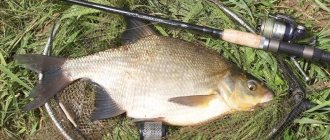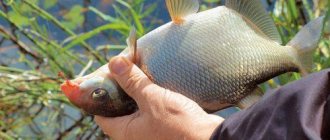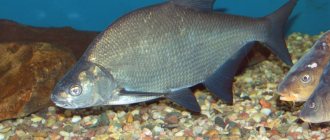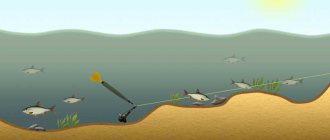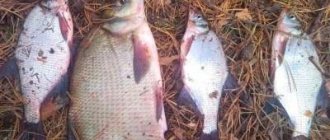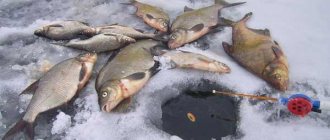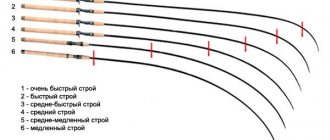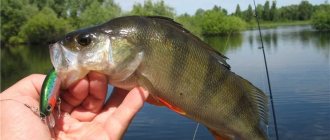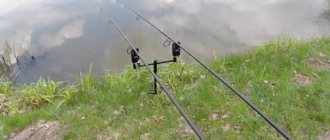Habits of lake bream
Lakes with a muddy bottom are the most popular for bream. Moreover, regardless of their depth. In such lakes the population of this fish is evenly distributed.
In windy weather, waves rushing onto the shore wash away many larvae from the ground. The bream will not miss the opportunity to have a free lunch, and will certainly approach the shore.
Bream are actively searching for food all summer, including Indian fish. With the arrival of cold mornings, schools of this fish begin to look for places for the upcoming winter. As a rule, they use deep holes for this purpose.
The diet of bream includes:
- insect larvae;
- shellfish;
- worms;
- some types of leeches;
- molting crayfish;
- seaweed;
- young shoots of aquatic vegetation.
Breams are often characterized by the habits of a predator. They happily chase the fry. As a result, there is a possibility of catching it with a spinning rod. For the most part they turn purple, but classic bites also happen.
Bream has always been considered a cunning and cautious fish. Most often it can be found at the border of thickets of aquatic vegetation and open water. On deeper lakes, you should look for bream on the edges and holes. It usually rises to the coastline at night and closer to dawn.
This is general information. Only local fishermen - bream fishermen - can give a more accurate recipe. However, if you find yourself on an unfamiliar body of water, you can independently try to determine the “fishing spot” based on the following signs:
- Along the chains of rising bubbles, this is a school of bream rummaging at the bottom in search of larvae of underwater insects.
- By the unnatural shaking of the reed stalks, between which the fish scurry.
- The capture of even a small bream indicates the presence of bream itself in this reservoir.
For this fish, finding food, even in pitch darkness, is not difficult. Usually very large specimens swim out to hunt at night. During the daytime, they are cautious and only make short runs. Therefore, night bream fishing can be very effective.
Tackle for lake bream
Fishing for bream in still water has its own characteristics. It is known that you can catch it with a simple float, match or Bolognese fishing rod. But bottom and feeder gear are considered the most catchy. The fundamental differences between them are minimal. The main nuance is that the feeder is additionally equipped with a coil.
The feeder is a universal rod designed for using bottom fishing gear. The rod length is selected as follows:
- up to 3 meters – for shallow reservoirs;
- up to 3.5 meters - for deep water.
Please note the following points:
- The rod tip comes in different hardnesses and is additionally equipped with a bite alarm.
- A medium-sized spinning reel (3000), with an adjustable friction brake and a large spool.
- The main line should not be very thick so as not to alert the bream. Tensile test – 4.5 kg. Experienced fishermen successfully replace it with a braided cord. It has zero memory (not subject to stretching), therefore the bite is felt several times better.
- Leashes are used from fishing line 0.12 - 0.20 mm, length from 25 to 50 cm. The more intense the bite, the shorter the leash.
- Feeders are round or cylindrical, weighing up to 50 g.
- Hooks with extended shank No. 10 – 14.
The presence of a boat and an echo sounder can make a significant contribution to detecting places where bream are concentrated.
Baits and bait
An important stage in preparing for any fishing is to choose the right complementary foods. The shelves of fishing stores are decorated with various mixtures. But experienced fishermen prefer to cook them themselves. The characteristics of a particular body of water and the taste preferences of its underwater inhabitants are taken into account.
Bait for bream should have the following properties:
- Fragrant smell. The bream should like it. Too harsh - most likely, it will scare him away.
- Taste. There is an opinion that bream love sweets. Add sugar, or better yet honey.
- Color. To prevent the color of the bait from alerting the bream, you need to supplement it with bottom soil.
- Viscosity. Balls of food thrown into the water should not immediately crumble. When fishing on a lake, the viscosity should be medium.
- Uniformity. It is important that all components are fine and well mixed.
- Creation of turbidity. After casting the bait, a cloudy cloud forms in the water, showing the bream the path to the bait. Semolina and milk powder will do.
To attract the attention of bream, the following components of plant origin are used:
- cereals (semolina, pearl barley, millet, corn);
- sunflower seed cake;
- breadcrumbs;
- flavorings (vanillin, coriander, cloves, etc.)
The listed ingredients form the basis of any bait. To break up the lump of complementary food in stagnant lake water, bran is added to the composition.
For bait to give a good result it is necessary:
- Grind the resulting mixture until smooth.
- Be sure to add a binding element in the form of coastal soil.
- To stir thoroughly.
- Dilute with water in small portions to achieve a suitable consistency.
- Be sure to add fragments of bait to the resulting mixture!
- Shape the bait into balls the size of an orange, similar to how snowballs are made in winter.
For fishing in still lake water, the following recipe is suitable:
- millet porridge – 400 g;
- rye breadcrumbs – 300 g;
- roasted seed cake – 200 g;
- bran – 400 g;
- coriander, crushed – 2/5 tsp;
- clay from the bottom of the lake;
- bait elements.
In addition to successful bait, for effective fishing you need to choose the right bait. When fishing for bream, the following baits of plant origin are used:
- Bread crumb.
- Canned corn.
- Pasta.
- Potato pieces.
- Steamed grains.
- Pearl barley.
A simple recipe for making pearl barley for catching bream:
- 250 g of pearl barley are poured with 1.5 liters of water;
- Cook for 40 minutes, stirring;
- Remove from heat, add flavoring and add taste (salt, sugar);
- Let it brew for a few hours.
Animal baits are also widely used for catching bream:
- Dung and earthworms.
- Maggot.
- Bloodworm.
- Molting crayfish (special delicacy).
- Mayfly.
- Insect larvae.
Advice. It is wise to take several types of bait when possible when fishing. This will increase the chances of success.
Bait is the key to a good bite
When fishing for bream in the middle of summer, bait often becomes the key to a good catch. If we summarize the experience of all fishermen, a whole book would not be enough to describe all the components of bait and the secrets used in its preparation. The specificity of bait largely depends on the activity of the fish and the characteristics of the reservoir. But there are also general principles in preparing July bait for catching this fish:
- For complementary feeding, you can use both purchased and self-prepared mixtures;
- It is advisable to add peas, corn and other large fractions to purchased small-fraction baits. This helps to cut off small things when fishing;
- It is recommended to weigh down the bait used with soil from the fishing spot, but you should not pack the feeder tightly. The food should come out easily, forming a feeding spot;
- The bait should contain light elements. It is believed that a light spot on the bottom attracts fish from afar. Some anglers use colored pasta;
- The addition of various attractant additives is widely used. The main thing is not to overdo it! Sweet smells (vanilla, strawberry, honey) really attract bream if they are sweet “in moderation”. The groundbait must contain the attachment or bait that will be used for fishing;
- It is advisable to feed heavily in the evening.
Features of catching bream on the lake from the shore
The most promising places for catching bream in the lake are:
- deep holes and adjacent areas;
- upper edges of pits;
- boundaries of areas of aquatic vegetation and open water.
So the first thing you need to do is identify these places. But how to do this while on the shore? You need:
- Use a boat and measure the depths.
- Use a marker sliding float.
- Tap the bottom with a sinker. To do this, tie a lead weighing 50 g onto the fishing line. Make test casts. The task is to determine the edge. Having found it, put a clip on the fishing line. It will serve as a casting range limiter.
The next stage is the process of feeding the fish. This is one of the most important points, so it needs to be done correctly:
- if the edge is not far from the shore, then you can make feeding balls and throw them by hand to the fishing point;
- if the treasured place is far away, use special feeders. They operate according to the following principle: after casting, upon reaching the bottom, a sharp hook is made, the feeder opens, and the bait falls out to the bottom.
It is very important to cast the feeder tackle exactly into the feeding area.
For convenience, you can remember it by some signs on the opposite bank. At first the scatter is large, however, after a few fishing trips the sniper accuracy comes.
All you have to do is experiment a little with the attachments and the process will begin! You don’t need to hook the bream immediately, but only after a few seconds. At the same time, remember the weakness of his lips.
An important assistant in catching bream is a landing net with a long handle. Bream is famous for its fighting qualities. You should let him take a breath of air and his agility will weaken sharply. Under such hypnosis, carefully bring it closer and take it with a net.
Fishing technique and tactics
Real bream fishing always begins with choosing a place. The basic principles for choosing a place for fishing on a river and on a lake are the same. It is imperative to carefully examine the bottom of the reservoir, its depth and topography. Silty areas on the river are unlikely to be suitable. It is desirable that there are anomalies at the bottom: differences in depth, edges, where the likelihood of bream staying is much greater. A marker weight and a float will help you in this matter.
Measuring the depth can be done with a regular feeder rod, on which a weight is installed instead of a feeder. By counting down the time until the load falls to the bottom, you can calculate the depth at the fishing spot. With each rotation of the coil, the time of its fall is recorded. If the load falls slower, the depth increases, and vice versa. This way you can determine the distance to the perspective point, which is clipped on the reel.
The features of the bottom are determined as follows: if the bottom is muddy or overgrown with algae, then when winding the reel, a light but uniform load is felt, and the resistance is minimal. If the bottom is covered with shell rock or stone, a tapping sensation is felt in your hand. If the resistance suddenly disappears, it means the load has fallen into the hole. The load moves smoothly along the sandy bottom without sudden changes in the applied force.
The initial feeding of the fishing point is carried out: only 5-10 casts with quick emptying of the feeder when the rod jerks. The bait for primary feeding should be finely dispersed and well moistened, so that it reaches the bottom and only then begins to be washed away by the current. The second layer is applied on top of the first. It already consists of a mixture of different fractions with the addition of bait, which will be used for fishing.
After feeding, the actual fishing begins. You need to start with a small leash (about 40 centimeters), then the length changes as necessary. If the leash is long and the bait is bitten or chewed by fish, it needs to be shortened. If there are no bites, lengthen it.
While the bream is interested in the bait, the tip of the feeder rod will remain motionless. The fish swallows the bait and calmly moves away to the side. At this time, the bite is reflected on the rod. You should always carefully monitor the tip, otherwise the moment of biting will be missed. It is worth remembering that bream have weak lips, so sharp hooking can lead to loss of catch.

